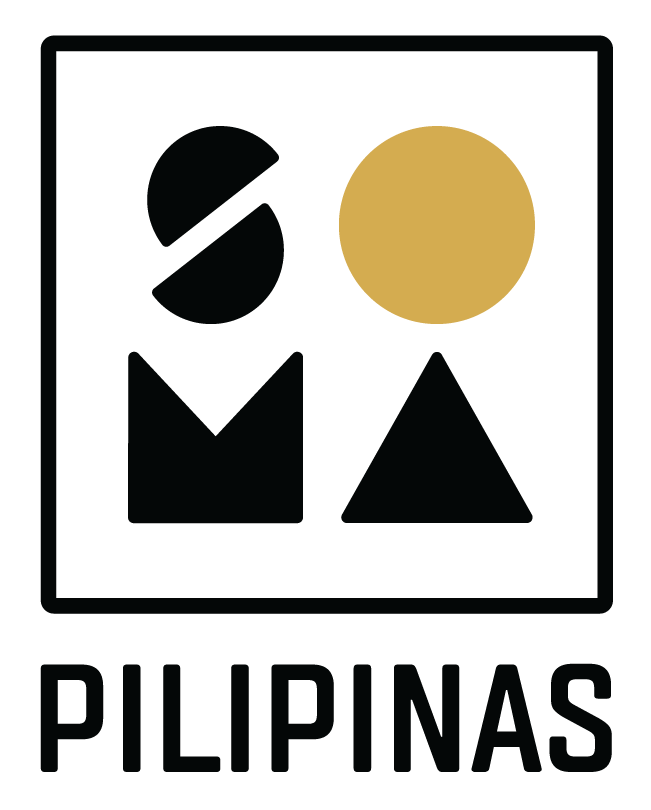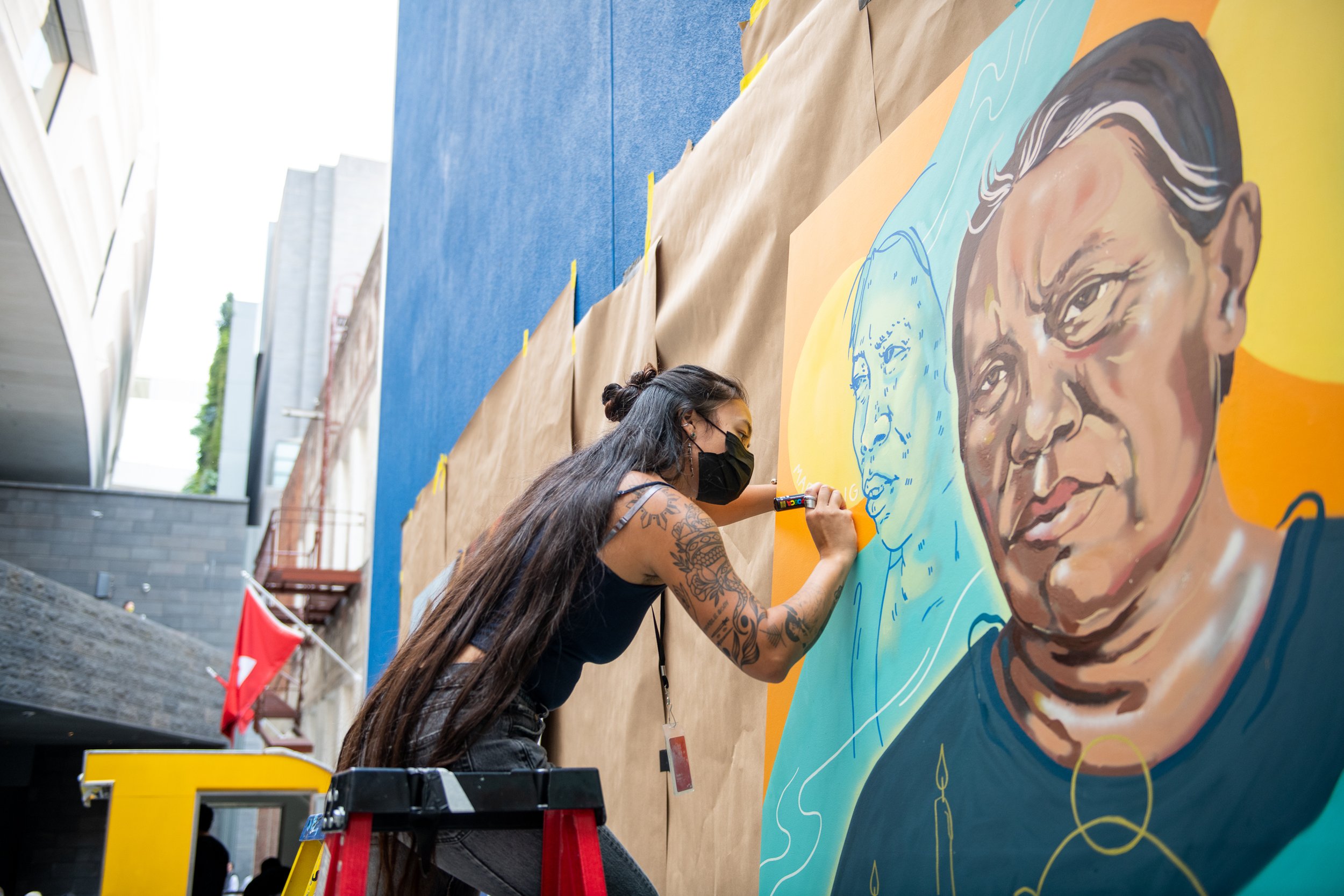Mini Murals at the new SOMA Pilipinas office
Franceska Gamez and Malaya Tuyay work on their murals during SFMOMA’s Mini Mural Festival. All photos by Beth Laberge.
In August 2021, SOMA Pilipinas hosted the last weekend of San Francisco Museum of Modern Art’s Mini Mural Festival. We invited visual artists Franceska Gamez and Malay Tuyay to paint 8x8 murals about cross-cultural solidarity. Their murals are now on display at our new office at the Yerba Buena Center for the Arts.
Pasalubong by Franceska Gamez
Artist Statement
This mural tells the story of healing, reclamation, and honoring our motherland. I draw inspiration from my memories of home, my experience as an immigrant, and my family’s stories. Some stories are about our joys and triumphs, while others are reminders of what we’ve endured. My Lola would share her experiences of WW2 in the Philippines, she was in her early 20s at the time. She told us about having to dress up as a man to escape to the next village with her family. It was common then for young women to be kidnapped, sexually enslaved, and sometimes left for dead- they were called “comfort women”.
The way she described it, I can never forget the image of a rifle with a bayonet. The pain was so vivid for her. This object was used to instill fear, it embodied violence, and was a reminder of everything that was taken from our people. I wanted to reclaim the images that instilled fear in my Lola. I believe that we are divinely connected to our ancestors- the experiences that marked them, leave imprints on us. This image that I painted on the left is of a woman- brave and bare, possessing the rifle and bayonet. In my vision, the rifle is useless as a weapon, instead its purpose is to carry sampaguita. The flowers symbolize divine hope, purity, strength, and love. She’s wearing an Ifugao Bakunawa (Dragon / Warrior) Mask. Stories of Bakunawa have been passed down through oral tradition, and in this painting I use it as an assertion of identity and connection to our roots. She stands tall, adorned with only a few things that matter, lifted up by her elders.
Centuries of colonization tried to make us forget that divine connection. The subjugation and oppression of our peoples continues to affect us collectively, in our mind, body and spirit. I wanted to draw attention to the fact that there is a health gap amongst indigenous and non-indigenous people. The rates in which people of color end their lives can also be directly linked to colonization and systemic oppression. This is the shadow we need to address, the collective healing we long for, the true freedom we seek.
Our connection to land is also more important than we realize. If enough generations are told that our land is not ours, then who will be left to defend it? Through the years I’ve come to my own peace and understanding of what motherland means to me, and I yearn to strengthen that bond. One of the ways to do that is to directly support our people back home, the true stewards of our land, the people on the ground fighting to defend it. The central figure is wearing a traditional Filipinana. Her butterfly-sleeves have transformed into familiar cascading mountains and waters that weave through the islands, as a reminder that our land is always with us, no matter how far we are.
Being an immigrant, I felt the distance and longing throughout my childhood. I was introduced to a new land and culture, and in exchange, I was separated from my mother, my father, and my siblings for years. They have always been my home. Separation from them has affected me in ways that I’m just now beginning to understand. My mother and eldest brother were the first to come to America. The paper planes and boats remind me of how they came here to build a new life with very little, making something out of nothing. The hope that they carried with them, the perseverance, and the many sacrifices they made in order for me to have the life I live now will never go in vain.
Free the Freedom Fighters by Malaya Tuyay
Artist Statement
Although I am here creating this mural through MoMA, I want to make clear that I do not support or stand by MoMA. MoMA as an institution, like many other institutions, has historically contributed harm to Black folks, Indigenous folks, folks of color and other marginalized peoples.
MoMA funders nationally have deep investments in evil projects including the Prison Industrial Complex, the zionist occupation of Palestine, the manufacturing of weapons egregiously used against Black and brown people globally and more.* I chose to do this project because I want to redistribute funds and honor Adelaida Macusang & Mumia Abu-Jamal. I am not convinced that MoMA will ever be able to fully support the liberation of our most vulnerable people, so long as they are tied to funders that actively harm our communities. I choose to follow and support the work by community organizers and activists who have have dedicated their lives' work toward collective freedom.
There are open asks from the community to SFMoMA that aligns with the concept of cross-cultural solidarity that SFMoMA has yet to follow through with. In the spirit of solidarity, I urge you to show up and do that work.
*Info from: folks from Campaign to Bring Mumia Home
Adelaida Macusang
Adelaida “Nanay Ede” Macusang was a peasant activist and member of Montevista Farmers Association (MONTEFARMA) in Davao de Oro, who fought to defend the peasant struggle in Southern Mindanao, where peasants work not only to expose the injustices they face, but also to create sustainable alternatives, such as communal farming initiatives which produce reliable harvests and building unity amongst peasants. Nanay Ede was detained under the imposition of Martial Law in Mindanao from 2018-2020 due to false charges of firearms and bombs that were planted inside her home, a common tactic used to attack activists. Nanay Ede was diagnosed with hypertension and heart enlargement before her arrest, and due to neglect and poor conditions on the inside, Nanay Ede tragically passed away in May 2020 due to cardiac arrest and kidney failure. Nanay Ede and all other detainees deserve justice! We do not want to see what happened to Adelaida Macusang and so many others who fall victim to the Prison Industrial Complex happen anymore. Defend the defenders and free our freedom fighters!
Mumia Abu-Jamal
Mumia Abu-Jamal is a veteran Black Panther, MOVE supporter, organizer, jailhouse lawyer, award-winning radio journalist, graduate student at UC Santa Cruz, author and father.
Known as “the voice of the voiceless” for many years of elevating the voices of the working class, Black and brown people, prisoners, and more, he was targeted and framed for the murder of a cop in 1981. He was convicted on perjured testimony and manufactured evidence.
It’s urgent that we come together for the freedom of Mumia, as he faces elder abuse and medical neglect on serious health complications, including congestive heart failure, liver damage, a severe chronic skin condition, and recent recovery from COVID-19 and open heart surgery. It is time to bring Mumia home.
Free Mumia Abu Jamal!
Free All Political Prisoners!
All Power to the People!
Long Live Revolution!
About the Artists
Photo by Beth Laberge.
Franceska Gamez is a visual artist, born in Manila and raised the Bay Area. Both cultures nurtured her identity and practice as the artist she is today. You can find her creating large-scale public murals, fully immersive installations, and tiny palm-sized sculptures. Her work is characterized by an elegant blend of abstract and representational forms in which she tells stories, illuminating emotions that envelope them. Her practice in the arts has led to dynamic bouts in installation, carpentry, writing, curation, art conservation, and project management. Her mural work can be seen throughout California, the East Coast, as well as overseas in Europe and Southeast Asia.
Malaya Tuyay is from small town Carpinteria, but now works and lives in the Bay Area. She channels the legacies of print and textile mediums to share her experience with trauma and her process of loving the different intersections of her queer mixed Pilipinx-American identity. She draws from this personal experience of losing her mother at a young age to create real and tactile objects out of grief. Her craftwork—particularly sewing and printmaking— is inspired by and in deference to the history of marginalized groups who often used these mediums to pass on their own stories, which are not retold or recognized in the canonical history classes of western institutions. In exhibiting work, she seeks to initiate conversations with others in the process of defining their own identities and to bring people together to exchange personal histories and collectively empower each other to create a radically new world. She further embodies this ethos by mobilizing her art practice in support of mutual aid organizing in the Bay Area and international advocacy work supporting frontline environmental defenders in Mindanao, Philippines.






